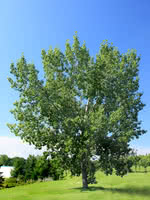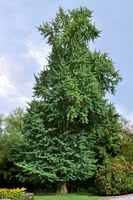Mon-Fri 9am - 5pm Mountain time
Balsam Poplar vs Ginkgo Biloba
Populus balsamifera
Ginkgo biloba
NOT AVAILABLE THIS SEASON - MIGHT RETURN
Balsam Poplar is a hardy, fast-growing deciduous tree that is Native to Canada east of the Rockies.
We grow them in two variations. Sometimes they are a male clones, so they don't produce fluff. Other times, we grow them from seed, which will result in fluff. The detailed descriptions (see below) will tell you which is which.
The Ginkgo Biloba is regarded as one of the most distinctive and beautiful of all the deciduous trees, and has remained genetically unchanged for millions of years. Its beautifully fan-shaped leaves develop a clear yellow colour in fall. Graceful and attractive year-round, Ginkgo is the perfect conversation starter in your yard.
Balsam Poplar Quick Facts
Ginkgo Biloba Quick Facts
Toxicity: Uncooked nuts in large quantities
In row spacing: 2.4 - 3 m (8 - 10 ft)

